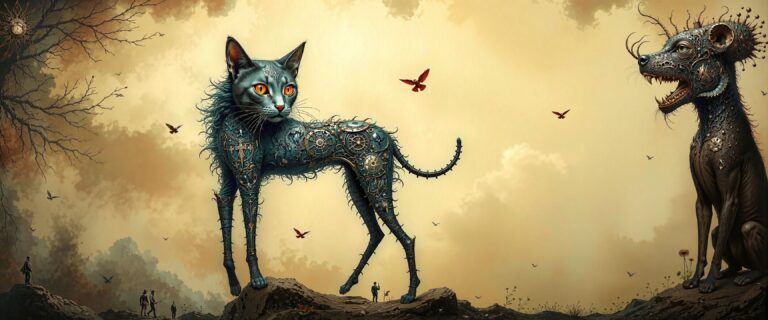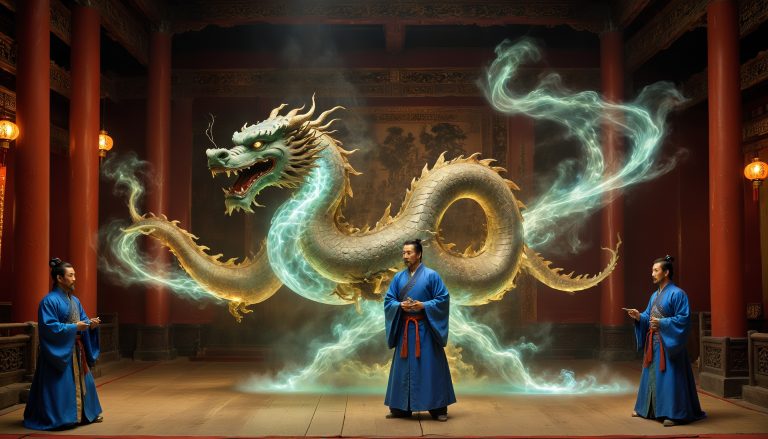Prehistoric Opera: A Symphony of Earth and Spirit
In an era when the bond between humanity and the natural world was profound and indissoluble, there emerged a form of communal expression that transcended mere survival, evolving into a profound celebration of life’s cycles, the elemental forces, and the spirits that animated the ancient landscapes. This was an early manifestation of what might be termed an opera, distinct in its lack of modern conventions yet rich in its depth of spirituality and communal significance. Held in the heart of an ancient forest, this prehistoric opera was a testament to the creativity, ingenuity, and spiritual depth of our ancestors.
Setting
Nestled within an ancient forest lies a clearing, surrounded by towering trees, with a large, flat stone at its center. This natural amphitheater, illuminated by the golden glow of torches and the moon, sets the stage for a magical convergence. Spectators gather, seated on the earth itself or on natural stone risers, forming a circle around the central space.
Narrative and Performance
At the heart of this opera is the deep, intrinsic connection between humans and the natural world. The performances unfold stories of the changing seasons, the eternal cycle of life and death, and the gods and spirits that dwell within the forest’s embrace. Performers emerge from the shadows of the woods, appear atop nearby rocks, or weave through the crowd, erasing the boundaries between the observers and the observed, enveloping all in a dynamic, immersive experience.
Costumes and Instruments
The costumes are crafted with care, designed to either merge with the forest backdrop or stand in vibrant contrast, made from leaves, vines, and animal hides. The music, carried by the forest’s natural acoustics, features instruments that mimic the sounds of the wild: drums that echo thunder, flutes that sing like birds, and strings that whisper with the voice of rustling leaves.
Audience Engagement
The audience is far from passive; they are integral to the opera’s unfolding, invited to participate in chants and rhythms, fostering a sense of communal identity and shared experience. This active involvement transforms the opera into a deeply immersive ritual, with the natural setting enhancing the collective engagement and unity.
Symbolism
Within this context, the elements—earth, air, fire, and water—play roles far beyond mere scenic backdrops. They are active participants in the narrative: fire brings light and symbolizes transformation; water mirrors the flow of life and the depth of emotions; the earth embodies stability and fertility; while the air carries the whispers of spirits and the divine.
Conclusion
This prehistoric opera serves as a celebration of the natural world and humanity’s intricate relationship with it. It honors the power, beauty, and mystery of the cosmos as perceived by ancient peoples. Through this communal ritual, a profound connection is forged between the earthly and the ethereal, engaging all senses and drawing the community together in a shared sense of awe and reverence.
Tonality of Prehistoric Opera
The tonality of prehistoric opera invites us to explore how early humans might have expressed themselves musically, using the sounds and materials available in their environment. Given that prehistoric societies were deeply connected to the natural world around them, it’s plausible that the tonality of their music would reflect this relationship, embodying both the harmony and the rawness of nature.
Modal and Pentatonic Scales
The music likely relied on simple scales, such as pentatonic (five-note) scales, which are found in many traditional music forms around the world. These scales have a universal appeal, possibly because they mimic naturally occurring sounds and human vocal ranges. The use of modal scales, which predate the major-minor tonality system of Western music, could also have been prevalent, providing a wide range of emotional expressions from serene and contemplative to more dynamic and dramatic.
Natural Harmonics and Overtones
The tonality might have been influenced by natural harmonics and overtones—subtle sonic textures produced when sound waves interact. Early humans, attentive to the sounds of their environment, may have incorporated these elements into their music, enhancing the emotional impact and spiritual resonance of their performances.
Rhythmic Complexity
Rhythm would have played a crucial role, possibly even more than melody. The use of drums and percussive instruments made from natural materials (wood, stones, animal skins) would allow for complex rhythmic patterns. These patterns could mimic the sounds of rain, thunder, the rustling of leaves, or the footsteps of animals, thereby grounding the music in the experiences of daily life and the cycles of nature.
Call and Response
The tonality could also have been characterized by the use of call and response, a form of interaction where a leader’s musical phrase (the call) is echoed by a chorus or the audience (the response). This form of musical communication fosters a sense of community and participation, vital in prehistoric societies.
Vocal Qualities
Vocally, the opera might have utilized a wide range of sounds beyond what is common in contemporary Western singing. This could include guttural tones, yelps, cries, and other vocalizations that express a broad spectrum of emotions and stories. The use of vocal ornamentation—slides, trills, and microtonal variations—could add layers of meaning and expression to the music.
Conclusion
The tonality of prehistoric opera, then, can be imagined as a rich tapestry of sounds drawn from the natural world and human emotion, designed to resonate with the listeners on a fundamental level. It would have been a music that speaks to the universal experiences of life, death, love, struggle, and the sacred, rooted in the rhythms and sounds of the earth itself.
Music Instruments and Vocal Structures in Prehistoric Opera
In a prehistoric opera, whether set against the backdrop of a tram-propelled stage or in the heart of nature, the orchestra and choir would significantly differ from their modern counterparts. They would be comprised of elements deeply rooted in the environment and the materials available to prehistoric peoples. Let’s explore how these foundational aspects of the opera might be imagined:
Orchestra
The “orchestra” in such an opera would likely consist of instruments made from natural materials, each chosen for its ability to produce a distinct sound that resonates with the natural world:
-
Drums and Percussion: Made from animal hides stretched over frames of wood or bone, these instruments provide the heartbeat of the performance, offering a range of sounds from deep booms to sharp cracks, depending on their size and the materials used.
-
Flutes and Wind Instruments: Crafted from bones, wood, or reeds, these instruments mimic the sounds of the wind, bird calls, and other natural phenomena, adding melody and harmony to the orchestra.
-
Stringed Instruments: Using sinew, plant fibers, or animal gut stretched over frames or shells, prehistoric stringed instruments could create drones or melodic lines, though likely more rudimentary than modern stringed instruments.
-
Idiophones: Stones, shells, or wooden pieces struck together to produce music. These could range from simple clapping stones to more complex wooden xylophones or marimbas.
-
Rasps and Scrapers: Instruments made by carving notches into sticks or bones, which are then scraped with another stick or bone to produce rhythmic sounds.
Choir
The choir would be an assembly of voices, utilizing a wide range of vocal techniques that might extend beyond the singing methods familiar to us today:
-
Calls and Cries: Vocalizations that emulate the sounds of animals or the elements (wind, thunder) could be a significant part of the choir’s repertoire, used to tell stories or invoke the presence of deities or spirits.
-
Harmonies: While complex polyphony (multiple independent melodic lines sung simultaneously) is unlikely due to its development much later in musical history, simple harmonies using drones or parallel intervals (octaves, fifths) could create a rich, resonant sound.
-
Rhythmic Chanting: Repetitive, rhythmic vocal patterns would play a crucial role, both in maintaining the opera’s pace and in involving the audience in the performance, perhaps through call-and-response sections.
-
Vocal Effects: The choir might also use non-linguistic vocal sounds—such as whispers, shouts, and other vocal effects—to convey emotion or depict natural sounds, adding another layer to the opera’s auditory landscape.
In this prehistoric setting, the orchestra and choir would not only provide musical accompaniment but also serve as vital narrators of the opera’s story, using their sounds to evoke the natural environment, depict the opera’s characters and events, and engage the audience’s senses in a profound communal experience. The integration of natural materials and the emphasis on a direct connection with the environment would make the music of such an opera a powerful reflection of prehistoric humanity’s relationship with the world around them.
Synopsis of "Whispers of the Forgotten Land"
In the tradition of crafting operas that resonate with deep, emotional themes, we conceive “Whispers of the Forgotten Land”, a tragic opera set in a prehistoric era, emphasizing the profound connections and conflicts between human communities and the untamed forces of nature. This tramless opera explores themes of loss, redemption, and the indomitable spirit of humanity facing insurmountable odds.
Act 1: The Omen
Scene 1: The opera unfurls in a verdant, thriving community, deeply connected with the rhythms of nature. The chorus, embodying the voice of the land, sings of the earth’s generosity and the delicate balance that sustains life. The music, layered with the sounds of wind instruments and gentle percussion, sets a tone of harmony and peace, yet a subtle dissonance hints at impending change.
Scene 2: Caelum, the wise elder, alone as the community sleeps, is visited by visions of desolation—a future where the land is barren, and the community is in despair. His solo aria, “Echoes of the Void,” is a haunting melody that weaves his fear and sorrow with the steadfast hope of finding a path to salvation. The orchestration builds around his voice, with strings and wind instruments creating a soundscape that mirrors the swirling chaos of his vision.
Scene 3: At dawn, Caelum stands before the community, his voice grave as he shares his ominous premonition. The music here is a complex interplay of voices and instruments, reflecting the community’s range of reactions—from disbelief and fear to a rallying cry for action. This scene closes with a powerful ensemble piece, “The Chorus of Fate,” where the community vows to face whatever future comes together.
Act 2: The Fracture
Scene 1: Nature’s wrath begins to manifest. Storms ravage the crops, and mysterious illnesses weaken the community. The chorus, now a voice of turmoil, reflects the chaos unleashed upon the land. The music is turbulent, with percussion and brass underscoring the severity of the crisis. Visuals of dark clouds and torrential rain accompany the chorus, enhancing the sense of a world turned hostile.
Scene 2: Seeking answers, Caelum ventures into the heart of the forest, a place where the boundary between the physical and spiritual worlds is thin. His aria, “Whispering Shadows,” calls to the spirits for guidance. The setting is ethereal, with minimalist staging and lighting to focus on Caelum’s solitary figure. The music is sparse, with harp and flute creating a sense of otherworldliness, punctuated by moments of silence that amplify his isolation and desperation.
Scene 3: Meanwhile, Varro, driven by a desire to protect his people through strength, rallies a faction to take arms against the perceived threats of the wild. His aria, “The Call to Arms,” is bold and fiery, backed by robust brass and percussion. The staging contrasts sharply with Caelum’s spiritual journey, emphasizing the division within the community. The scene ends with Varro leading his followers out of the village, a determined and formidable force set against a backdrop of discordant music that foreshadows tragedy.
Act 3: The Descent
Scene 1: The community splinters, with half following Varro on a perilous mission to confront nature head-on, while the others remain, placing their faith in Caelum’s wisdom. This scene is a dramatic juxtaposition of the two paths, with music that alternates between the aggressive, martial themes of Varro’s followers and the more introspective, melancholic motifs representing those who stay behind. The staging uses the opera’s space innovatively, dividing it to show the parallel narratives unfolding.
Scene 2: Varro’s confrontation with the wilderness leads to a catastrophic encounter with a fierce storm and a devastating landslide, symbolizing the futility of fighting nature. The music here is a cacophony, mirroring the chaos of the battle and the overwhelming force of the natural world. The visuals are stark, with lighting and special effects creating an immersive experience of the disaster.
Scene 3: Caelum and his followers discover the source of the land’s wrath: a sacred grove, desecrated and forgotten. The music, “Lament of the Sacred,” is a sorrowful acknowledgment of the community’s disconnect from their spiritual roots. The scene is visually poignant, with the desecrated grove represented by a single, withered tree under a spotlight, symbolizing the lost sanctity.
Act 4: The Reconciliation
Scene 1: In a climactic act of sacrifice, Caelum offers himself to restore balance and heal the land. His final aria, “Embrace of the Earth,” is a powerful testament to his love for his people and the natural world. The music swells in a crescendo of strings and choir, capturing the moment’s gravity. The visual tableau is striking, with Caelum enveloped in a beam of light as he merges with the land.
Scene 2: The community gathers to mourn Caelum’s sacrifice and to honor his wisdom. The music, “The Weave of Life,” is a reflective piece that blends mournful melodies with hopeful undertones, signifying the community’s journey through grief towards understanding. Choir and orchestra unite in a harmonious blend, reflecting the unity of the community as they come together to honor Caelum. The stage is adorned with symbols of Caelum’s life—a cloak, a staff, and representations of the natural elements he revered. As the community members lay tokens at the base of the withered tree, now beginning to blossom, the lighting subtly shifts from cool blues to warm, life-affirming golds and greens, symbolizing renewal and growth.
Scene 3: The final scene opens with the first hints of dawn, the music gentle yet filled with a palpable sense of new beginnings. “Dawn of the Renewed Land” is a symphony of hope, blending elements of the themes heard throughout the opera to signify the healing of the land and the community’s renewed bond with nature. The stage is transformed to show the once-barren land now teeming with life—flowers bloom, streams flow, and the tree in the sacred grove stands tall and vibrant. The community, united, sings of their resolve to live in harmony with the land, their voices rising in a powerful chorus that fills the amphitheater. As they sing, the performers and audience alike are enveloped in the immersive sounds of nature—birdsong, wind through leaves, and the gentle murmur of water—created by the orchestra and ambient sound design. This integration of natural sounds with the music blurs the line between performance and the world outside, drawing the audience deeper into the experience.
The opera concludes with the entire cast on stage, facing the dawn. The final note, a sustained chord from the orchestra that slowly fades, leaves a lingering sense of peace and unity. The lighting dims to a soft glow, mimicking the first light of dawn, as the characters hold their final pose, a tableau of resilience and hope. The audience is left with a profound sense of connection to the themes of the opera—respect for nature, the importance of community, and the power of sacrifice for the greater good.
As the curtain falls, “Whispers of the Forgotten Land” cements itself as not just a story of ancient times but a timeless reflection on humanity’s relationship with the natural world, a call to remember the bonds that tie us to the earth and to each other.
Actual knowledge about the theme
History of Opera and Prehistoric Music
-
The Origins of Opera:
- Opera began in Italy at the end of the 16th century, combining music, drama, art, and, in some cases, dance to tell a story entirely through music. The first work considered an opera is “Dafne,” composed by Jacopo Peri in 1597, though the earliest surviving opera is “Euridice” (1600), by Peri and Giulio Caccini.
-
Prehistoric Music and Instruments:
- The study of prehistoric music, or “archaeomusicology,” focuses on the music of cultures without written records. Instruments dating back to the Paleolithic era, such as flutes made from bird bones and mammoth ivory, found in sites like the Geißenklösterle cave in Germany, are among the oldest known musical instruments, suggesting music’s role in prehistoric societies.
-
The Evolution of Musical Notation:
- Musical notation has evolved significantly over the centuries. The earliest forms of notation can be traced back to ancient civilizations, including the Sumerians and Greeks. However, the system that would lead to modern Western musical notation began to develop in the Medieval period, with Guido d’Arezzo’s innovations in the 11th century being particularly influential.
-
The Role of Music in Ancient Rituals and Ceremonies:
- In many ancient cultures, music played a central role in religious and ceremonial life, used to accompany rituals, communicate with deities, and mark significant community events. This tradition underscores the deep connection between music and the sacred, seen in societies ranging from ancient Egypt and Greece to Indigenous cultures around the world.
-
The Transition from Medieval Music to Renaissance Music:
- The transition from the Medieval period to the Renaissance around the 15th century marked significant changes in musical style and practice. This period saw the rise of polyphony, a greater emphasis on harmony, and the development of music printing technologies. Composers like Josquin des Prez and later Palestrina would come to define the era’s sound, paving the way for the Baroque period and the eventual development of opera.
First Operas
- Florentine Camerata: A group credited with developing the first operas in Renaissance Florence.
- Jacopo Peri: Considered one of the inventors of opera, composer of “Dafne” and “Euridice”.
Early Opera Works
- Euridice (Peri): The earliest surviving opera, telling the story of Orpheus and Eurydice.
Prehistoric Music
- Prehistoric Music: Music produced in preliterate cultures, beginning in late geological history.
Musical Instruments in Prehistory
- Paleolithic Flutes: Among the earliest known musical instruments, dating back to the Upper Paleolithic era.
The Origins of Opera
- Opera: Overview of the art form, tracing its origins from the Renaissance era in Italy.


















